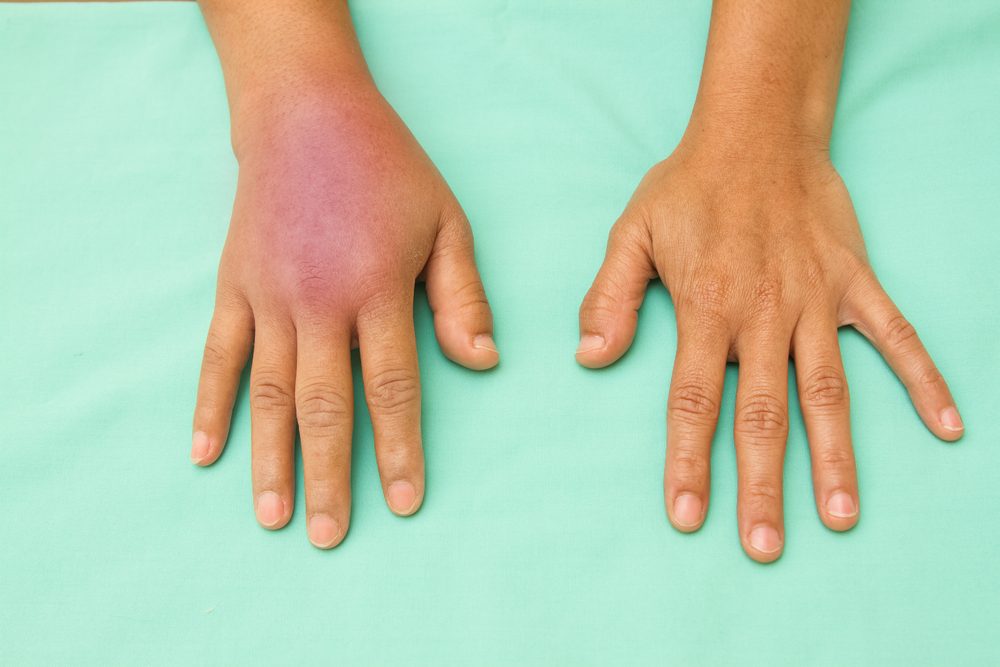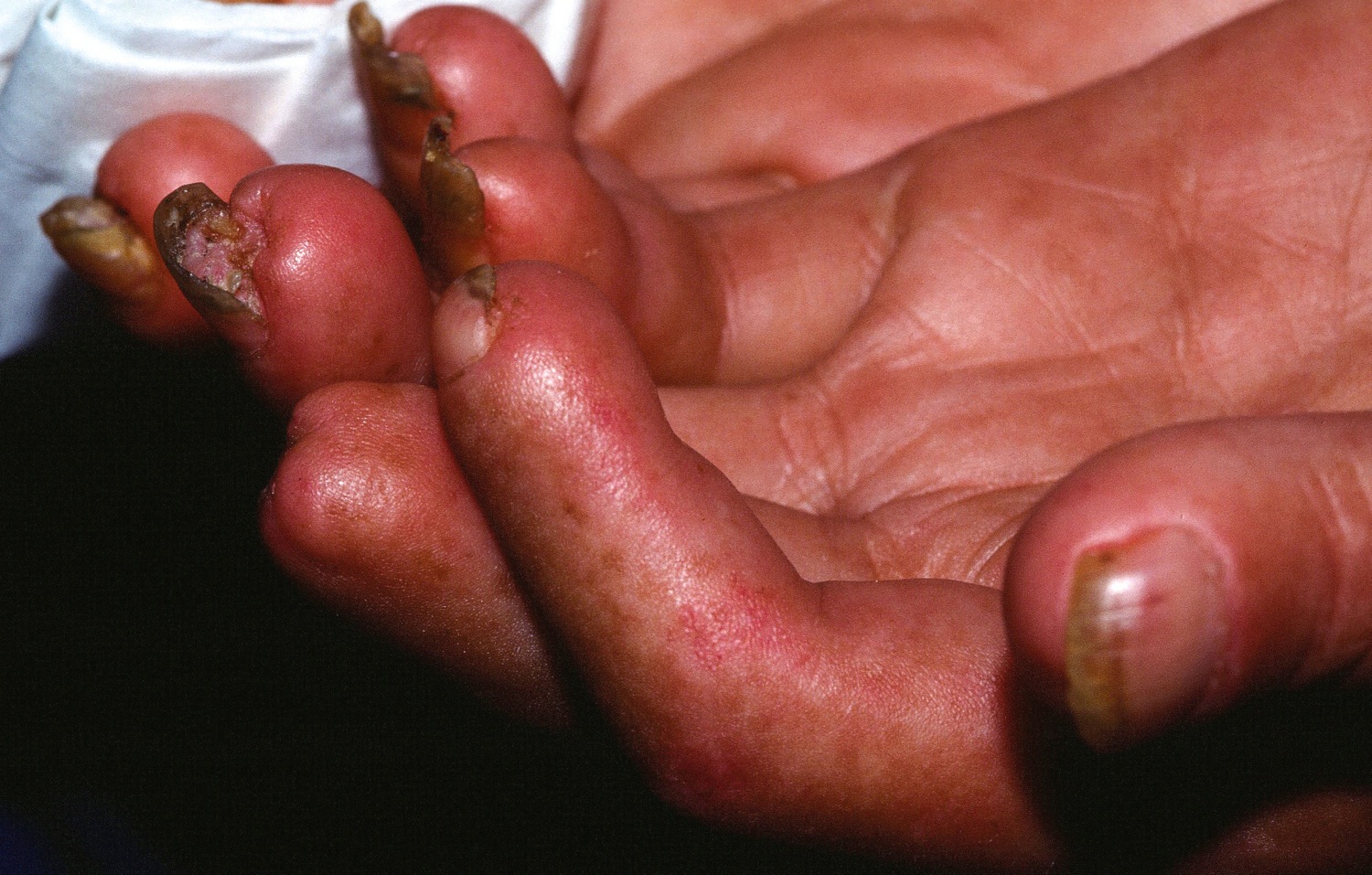
Scleroderma
Systemic Sclerosis (SS) Systemic sclerosis (SS) is an autoimmune disorder. This means it’s a condition in which the immune system attacks the body. Healthy tissue is destroyed because the immune.
Quick Links |
|---|
|
Scleroderma, or systemic sclerosis, is a chronic connective tissue disease generally classified as one of the autoimmune rheumatic diseases.
The word “scleroderma” comes from two Greek words: “sclero” meaning hard, and “derma” meaning skin. Hardening of the skin is one of the most visible manifestations of the disease. The disease has been called “progressive systemic sclerosis,” but the use of that term has been discouraged since it has been found that scleroderma is not necessarily progressive. The disease varies from patient-to-patient.
What scleroderma is not
Scleroderma is not contagious, infectious, cancerous or malignant.
How serious is scleroderma?
Any chronic disease can be serious. The symptoms of scleroderma vary greatly for each person, and the effects of scleroderma can range from very mild to life threatening. The seriousness will depend on the parts of the body, which are affected, and the extent to which they are affected. A mild case can become more serious if not properly treated. Prompt and proper diagnosis and treatment by qualified physicians may minimize the symptoms of scleroderma and lessen the chance for irreversible damage.
How is scleroderma diagnosed?
The diagnostic process may require consultation with rheumatologists (arthritis specialists), and/or dermatologists (skin specialists) and require blood studies and numerous other specialized tests depending upon which organs are affected.

Who develops scleroderma, and when?
It’s estimated that about 300,000 Americans have scleroderma. About one third of those people have the systemic form of scleroderma. Since scleroderma presents with symptoms similar to other autoimmune diseases, diagnosis is difficult. There may be many misdiagnosed or undiagnosed cases.
Localized scleroderma is more common in children, whereas systemic scleroderma is more common in adults. Overall, female patients outnumber male patients about 4-to-1. Factors other than a person’s gender, such as race and ethnic background, may influence the risk of getting scleroderma, the age of onset, and the pattern or severity of internal organ involvement. The reasons for this are not clear. Although scleroderma is not directly inherited, some scientists feel there is a slight predisposition to it in families with a history of rheumatic diseases.
However, scleroderma can develop in every age group from infants to the elderly, but its onset is most frequent between the ages of 25 to 55. When doctors say 'usually' or 'for the most part,' the reader should understand that variations frequently occur. Many patients get alarmed when they read medical information that seems to contradict their own experiences, and conclude that what has happened to them is not supposed to happen. There are many exceptions to the rules in scleroderma, perhaps more so than in other diseases. Each case is different, and information should be discussed with your own doctor.
What causes scleroderma?
The exact cause or causes of scleroderma are still unknown, but scientists and medical researchers are working hard to make those determinations. It is known that scleroderma involves an overproduction of collagen.
Is scleroderma genetic?
Most patients do not have any relatives with scleroderma and their children do not get scleroderma. Research indicates that there is a susceptibility gene, which raises the likelihood of getting scleroderma, but by itself does not cause the disease.
What is the treatment for scleroderma?
Currently, there is no cure for scleroderma, but there are many treatments available to help particular symptoms. For instance, heartburn can be controlled by medications called proton pump inhibitors PPIs) or medicine to improve the motion of the bowel. Some treatments are directed at decreasing the activity of the immune system. Stickman free rider. Some people with mild disease may not need medication at all and occasionally people can go off treatment when their scleroderma is no longer active. Because there is so much variation from one person to another, there is great variation in the treatments prescribed.
Types of Scleroderma
There are two major classifications of scleroderma: localized scleroderma and systemic sclerosis (SSc). Other forms or subclassifications, each with its own characteristics and prognosis, may be identified through future research.
Localized Scleroderma The changes, which occur in localized scleroderma, are usually found in only a few places on the skin or muscles, and rarely spread elsewhere. Generally, localized scleroderma is relatively mild. The internal organs are usually not affected, and persons with localized scleroderma rarely develop systemic scleroderma. Some laboratory abnormalities commonly seen in systemic scleroderma are frequently absent in the localized form.
Morphea is a form of localized scleroderma characterized by waxy patches on the skin of varying sizes, shapes and color. The skin under the patches may thicken. The patches may enlarge or shrink, and often may disappear spontaneously. Morphea usually appears between the ages of 20 and 50, but is often seen in young children.
Linear scleroderma is a form of localized scleroderma which frequently starts as a streak or line of hardened, waxy skin on an arm or leg or on the forehead. Sometimes it forms a long crease on the head or neck, referred to as en coup de sabre because it resembles a saber or sword wound. Linear scleroderma tends to involve deeper layers of the skin as well as the surface layers, and sometimes affects the motion of the joints, which lie underneath. Linear scleroderma usually develops in childhood. In children, the growth of involved limbs may be affected.
Systemic scleroderma (systemic sclerosis) The changes occurring in systemic scleroderma may affect the connective tissue in many parts of the body. Systemic scleroderma can involve the skin, esophagus, gastrointestinal tract (stomach and bowels), lungs, kidneys, heart and other internal organs. It can also affect blood vessels, muscles and joints. The tissues of involved organs become hard and fibrous, causing them to function less efficiently. The term systemic sclerosis indicates that “sclerosis” (hardening) may occur in the internal systems of the body. There are two major recognized patterns that the illness can take - diffuse or limited disease. In diffuse scleroderma, skin thickening occurs more rapidly and involves more skin areas than in limited disease. In addition, people with diffuse scleroderma have a higher risk of developing “sclerosis” or fibrous hardening of the internal organs.
About 50 percent of patients have a slower and more benign illness called limited scleroderma. In limited scleroderma, skin thickening is less widespread, typically confined to the fingers, hands and face, and develops slowly over years. Although internal problems occur, they are less frequent and tend to be less severe than in diffuse scleroderma, and are usually delayed in onset for several years. However, persons with limited scleroderma, and occasionally those with diffuse scleroderma,
can develop pulmonary hypertension, a condition in which the lung’s blood vessels become narrow, leading to impaired blood flow through the lungs resulting in shortness of breath.
Limited scleroderma is sometimes called CREST syndrome. CREST stands for the initial letters of five common features:
- Calcinosis
- Raynaud Phenomenon
- Esophageal dysfunction
- Sclerodactyly
- Telangiectasia
To further complicate the terminology, some people with diffuse disease will go on to develop calcinosis and telangiectasias so that they also have the features of CREST.
Although most patients can be classified as having diffuse or limited disease, different people may have different symptoms and different combination of symptoms of the illness.
.Turok & Turok 2It might be hard to believe now, but before the one-two punch of Gears of War and Call of Duty 4 tethered the blockbuster shooter to beige reality, the genre had its fair share of colourful contenders. Still, the undeniable lure of blasting a T-Rex in the face with a grenade launcher continues to resonate with a great portion of the gaming public, and while few triple-A developers have proffered quality dino games, there are a few ambitious indie dinosaur games that fill the gap in the market.If dino thrills are what you’re looking for, here are the best dinosaur games on PC. Whether you’re looking to hunt the Mesozoic monsters or want to stomp and chomp humans while playing as them, the appeal of dinosaurs in gaming is endless. What is endless, however, is the number of games that successfully realise that fantasy. Truck simulator game 2019. Let’s be honest: until recently, fans of dinosaurs and big guns haven’t exactly walked the primrose path, even on PC.It’s been a long hard road, marked by velociraptors that look like lumpy dogs, rifles that feel as satisfying as lobbing a bullet by hand, and jeeps that seem to magnetically roll themselves into a nearby ditch, no matter what keys to press.